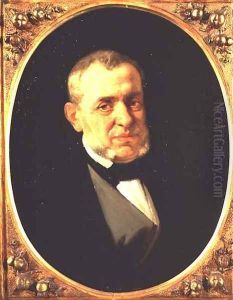Andrea Cefaly Paintings
Andrea Cefaly, born in 1838 in Catanzaro, a city in the southern region of Calabria, Italy, was an Italian painter associated with the Macchiaioli group, although his work also retains distinctive personal characteristics. The Macchiaioli were a group of Italian artists active in Tuscany in the second half of the 19th century, who broke away from traditional historical and classical subjects to paint landscapes and scenes of everyday life, focusing on the play of light and shadow. This movement is considered a precursor to Impressionism, although it developed independently of the French movement.
Cefaly's artistic journey began with his education at the Naples Academy of Fine Arts, where he was influenced by the prevailing Neoclassical and Romantic movements. However, his exposure to the Macchiaioli, especially during his time in Florence, marked a significant turning point in his stylistic development. He became particularly known for his landscapes and interior scenes, which were characterized by a sensitive use of light and an intimate portrayal of subject matter. Cefaly's works often depicted the rugged beauty of the Calabrian and Tuscan countryside, reflecting a deep connection to his native land.
Despite his association with the Macchiaioli, Cefaly maintained a certain independence in his artistic approach. He was less interested in the political implications of the group's work, focusing instead on a more personal and introspective exploration of light and color. His paintings, while embodying the Macchiaioli's emphasis on naturalistic light and shadow, also exhibit a distinctive tranquility and a focus on the spiritual aspects of landscape.
Cefaly's contributions to Italian art were recognized in his time, and he participated in important exhibitions, including those held in Turin and Florence, which were central to the promotion of the Macchiaioli movement. Despite this, he never achieved the same level of fame as some of his contemporaries. Today, his work is appreciated for its unique blend of Macchiaioli techniques with his own lyrical and introspective style.
Andrea Cefaly passed away in 1907, leaving behind a body of work that continues to be studied and admired for its quiet beauty and technical skill. His paintings are held in various Italian museums and galleries, serving as a testament to his role in the development of 19th-century Italian art. Through his landscapes and interiors, Cefaly invites viewers into a world where light, color, and form converge to create moments of serene beauty, making him a noteworthy figure in the history of the Macchiaioli movement.
